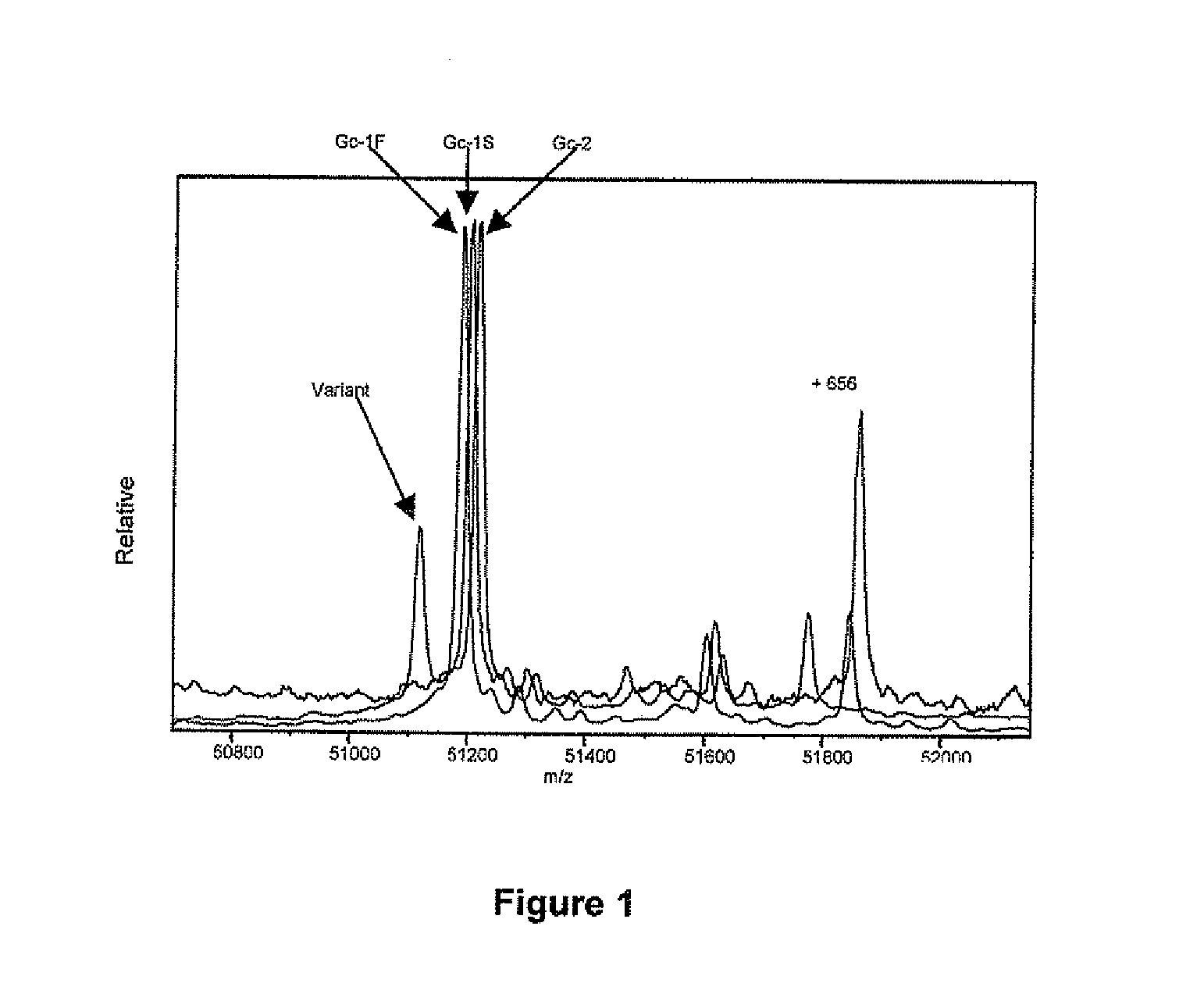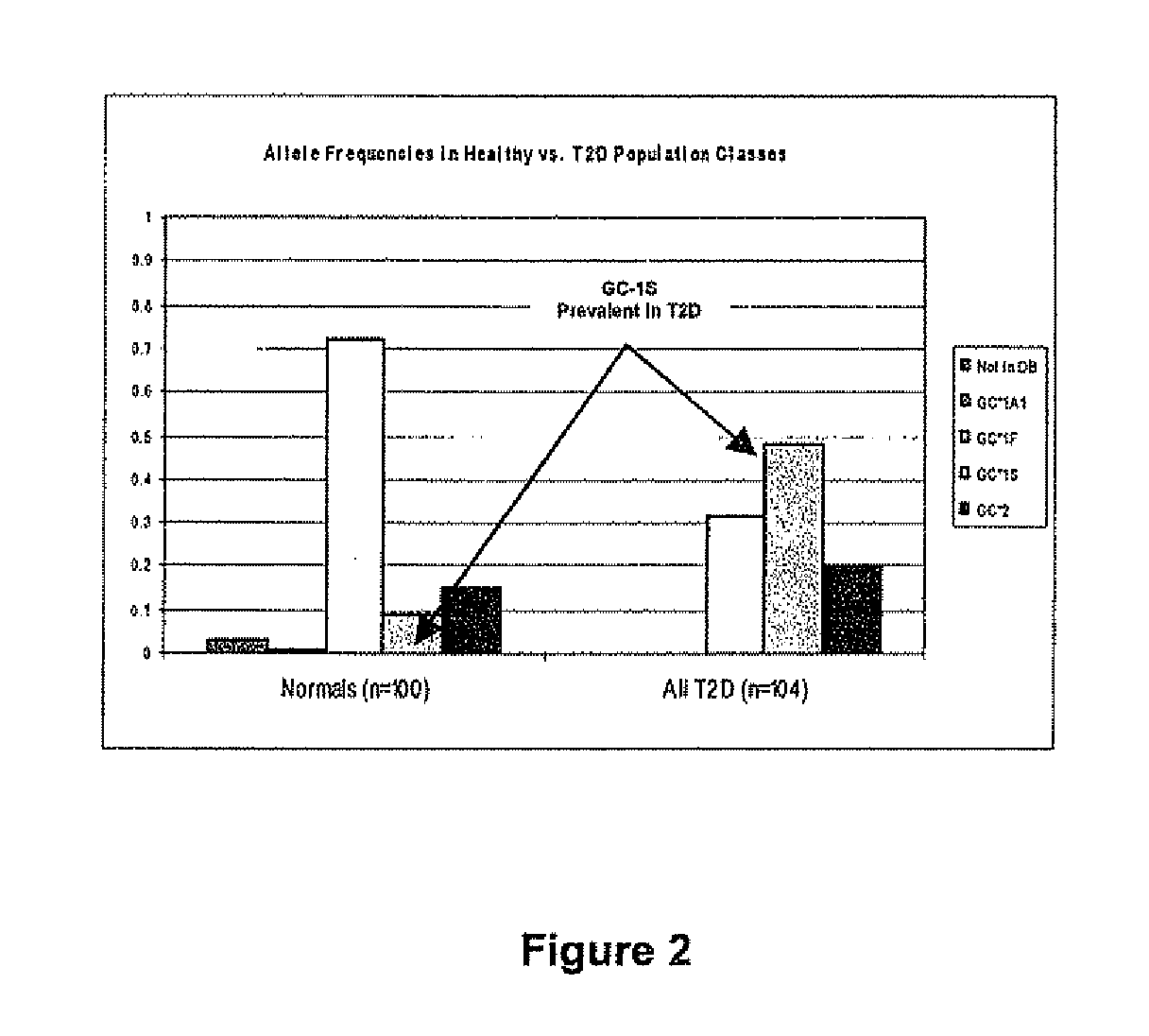Biomarkers and assays for diabetes
- Summary
- Abstract
- Description
- Claims
- Application Information
AI Technical Summary
Benefits of technology
Problems solved by technology
Method used
Image
Examples
example 1
Disease Subjects
Healthy, type 2 Diabetes (T2DM) and Insulin-Dependent Type 2 Diabetes (id T2DM)
[0055]Given below are examples of genetic, posttranslational and metabolic alterations obtained through population screening of subjects consisting of healthy individuals (not known to have ailments; n=50), T2DM individuals (diagnosed as T2DM and treated through diet, exercise and non-insulin drugs; n=37) and id-T2DM individuals (insulin-dependent, diagnosed as T2DM and treated through administration of insulin; n=15). EDTA-plasma samples were collected from these individuals (under informed consent and IRB approval) after 8-hours fasting, and stored at −70° C. until analyzed using the methods described below. Records of gender, race, BMI, medical history and current treatment were also obtained for each diabetic individual.
example 2
Population Proteomics and T2DM
[0056]Table 1 shows an exemplary list of 15 blood-borne markers (proteins & protein variants), each able to differentiate subjects between healthy and T2DM. It is important to note that all of the markers are due to the relative modulation of PTM's associated with physiological pathways known to be influential in the diagnosis or treatment of T2DM.
TABLE 1Summary of Protein (Variant) Markers found in T2DM SubjectsROCObservation(Area underProteinCategory(Ave: healthy vs T2DM)curve)Beta-2-Glycation0.7 vs. 2.5%.0.84microglobulinCystatin CGlycation1.0 vs. 3.8%0.93GcGGlycation0.9 vs. 4.8%0.98AlbuminGlycation 13 vs 27%0.93Hem A&BGlycation3.1 vs. 6.3% (b-chain)0.88-value1.7 vs. 3.4% (a-chain)using all8.2 vs. 13.6% (b-chain;Hemoglobin+120 Da)variantsAlbuminOxidation 40 vs. 25%0.96TTROxidation1.5 vs. 30%0.99Apo A1Oxidation 30 vs. 55%0.80Apo C1Oxidation8.8 vs. 28.9%0.98C-peptideEnzymatic4.8 vs. 9.0%0.85InsulinEnzymatic4.1 vs. 10.80.81
[0057]The hemoglobin MSIA dete...
example 3
Gc-Globulin (aka Vitamin D Binding Protein)
Genetic and Postranslational Modifications
[0062]Go-Globulin or GcG (also known as Vitamin D binding protein) is a plasma protein with a nominal molecular weight of ˜51 kDa and an estimated concentration in plasma of 200-600 mg / L. It is known to be present in human populations as three high-frequency allelic variants, Gc-1F, Gc-1S and Gc-2, as well as other low-frequency variants. Major biological roles for GcG include vitamin D metabolite transport, fatty acid transport, actin sequestration, and macrophage activation. Modification of this protein can thus constitute a biological event of wide-sweeping consequence.
[0063]During the course of investigation, genotypic and phenotypic variants of GcG were analyzed from blood plasma using immunoaffinity extraction followed by electrospray ionization mass spectrometry (ESI-MS). Human plasma samples (125 μL) were diluted 2-fold in HEPES-buffered saline (HBS) and placed in a 96-well titer plate. GcG ...
PUM
 Login to View More
Login to View More Abstract
Description
Claims
Application Information
 Login to View More
Login to View More - R&D
- Intellectual Property
- Life Sciences
- Materials
- Tech Scout
- Unparalleled Data Quality
- Higher Quality Content
- 60% Fewer Hallucinations
Browse by: Latest US Patents, China's latest patents, Technical Efficacy Thesaurus, Application Domain, Technology Topic, Popular Technical Reports.
© 2025 PatSnap. All rights reserved.Legal|Privacy policy|Modern Slavery Act Transparency Statement|Sitemap|About US| Contact US: help@patsnap.com



